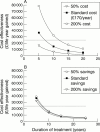Cost effectiveness of ramipril treatment for cardiovascular risk reduction
- PMID: 11303006
- PMCID: PMC1729730
- DOI: 10.1136/heart.85.5.539
Cost effectiveness of ramipril treatment for cardiovascular risk reduction
Abstract
Objective: To assess the cost effectiveness of ramipril treatment in patients at low, medium, and high risk of cardiovascular death.
Design: Population based cost effectiveness analysis from the perspective of the health care provider in the UK. Effectiveness was modelled using data from the HOPE (heart outcome prevention evaluation) trial. The life table method was used to predict mortality in a medium risk cohort, as in the HOPE trial (2.44% annual mortality), and in low and high risk groups (1% and 4.5% annual mortality, respectively).
Setting: UK population using 1998 government actuary department data.
Main outcome measure: Cost per life year gained at five years and lifetime treatment with ramipril.
Results: Cost effectiveness was pound36 600, pound13 600, and pound4000 per life year gained at five years and pound5300, pound1900, and pound100 per life year gained at 20 years (lifetime treatment) in low, medium, and high risk groups, respectively. Cost effectiveness at 20 years remained well below that of haemodialysis ( pound25 000 per life year gained) over a range of potential drug costs and savings. Treatment of the HOPE population would cost the UK National Health Service (NHS) an additional pound360 million but would prevent 12 000 deaths per annum.
Conclusions: Ramipril is cost effective treatment for cardiovascular risk reduction in patients at medium, high, and low pretreatment risk, with a cost effectiveness comparable with the use of statins. Implementation of ramipril treatment in a medium risk population would result in a major reduction in cardiovascular deaths but would increase annual NHS spending by pound360 million.
Figures




References
Publication types
MeSH terms
Substances
LinkOut - more resources
Full Text Sources
Medical
